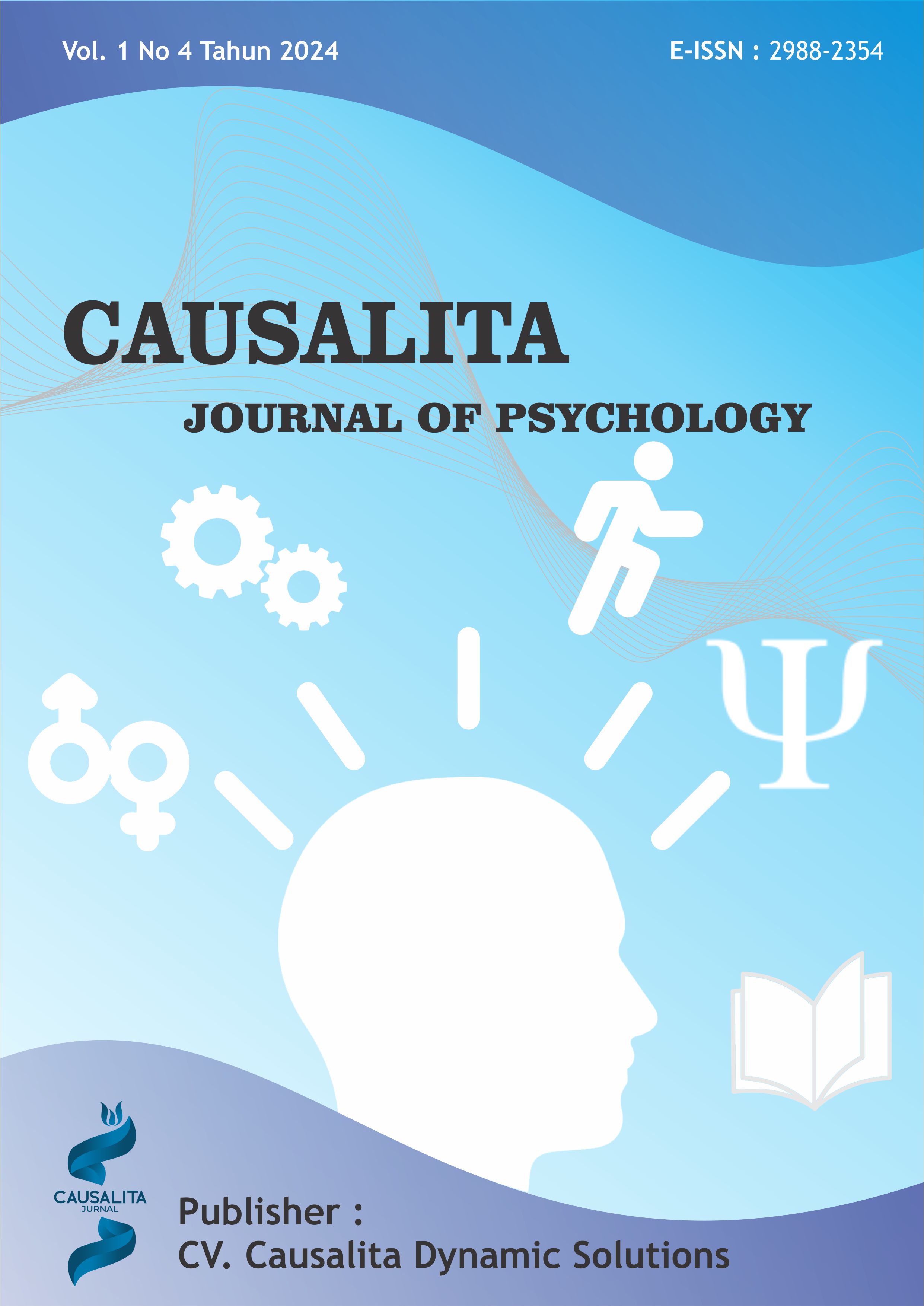Gambaran Social Interest pada Mahasiswa UKM Bahasa Asing Universitas Negeri Padang Pasca COVID-19 di Tinjau dari Jenis Kelamin
DOI:
https://doi.org/10.62260/causalita.v1i4.94Keywords:
Social Interest, Covid-19, GenderAbstract
Dengan sistem perkuliahan online selama COVID-19, kehidupan mahasiswa yang biasanya identik dengan kesibukan dalam kampus dengan berbagai kegiatan sosial lain, akhirnya memiliki banyak waktu sendiri. Hal ini cukup dikhawatirkan mengingat mahasiswa yang seharusnya aktif menjadi cenderung acuh dengan kondisi sosial. Tujuan dari penelitian ini adalah untuk mengetahui gambaran social interest pada mahasiswa UKM Bahasa Asing Universitas Negeri Padang Pasca COVID-19 di Tinjau dari Jenis Kelamin. Pada penelitian ini menggunakan teori social interest. Teknik sampel yang digunakan pada penelitian ini adalah accidental sampling. Pada penelitian ini memakai teknik analisis data uji t-test. Simpulan dari penelitian ini yaitu tidak ada perbedaan social interest terhadap mahasiswa UKM Bahasa Asing Universitas Negeri Padang pasca COVID-19 ditinjau dari jenis kelamin.
References
Apostolou, M., Keramari, D., Kagialis, A., & Sullman, M. J. M. (2020). Why people make friends: The nature of friendship. Personal Relationships, 28(1), 4–18. https://doi.org/10.1111/pere.12352
Adler, A. (1997). Understanding life : An introduction to the psychology of Alfred Adler.
Alizadeh, H., Ferguson, E. D., Murphy, J. M., & Soheili, F. (2017). Development of the social interest scale for iranian children aged 4-12 a qualitative model of knowledge, skills, and attitudes supporting adlerian-based trauma psychotherapy. The Journal of Individual Psychology, 73(1), 38-53. doi:10.1353/jip.2017.0003
Bandura, A. (1997). Self-efficacy: The exercise of control. New York: W. H. Freeman and Company
Bandura, A. (2012). On the functional properties of perceived self-efficacy revisited. Journal of Management, 38(1): 9–44. doi:10.1177/0149206311410606.
Bocquet-Appel, J.-P. (2011). When the world's population took off: The springboard of the Neolithic demographic transition. Science, 333, 560–561. https://doi.org/10.1126/science.1208880
Browning, Matthew H. E. M., Lincoln R. Larson, Iryna Sharaievska, Alessandro Rigolon, Olivia McAnirlin, Lauren Mullenbach, Scott Cloutier, et al. (2021). “Psychological Impacts from COVID-19 among University Students: Risk Factors across Seven States in the United States.” Edited by Chung-Ying Lin. PLOS ONE 16, no. 1 (January 7, 2021): e0245327. https://doi.org/10.1371/journal.pone.0245327.
Butler, J. K., & Cantrell, R. S. (1984). A behavioral decision theory approach to modeling dyadic trust in supervisors and subordinates. Psychological Reports, 55, 19–28.
Carney, J. M., Dobson, J. E., & Dobson, R. L. (1987). Using senior citizen volunteers in the schools. Journal of Humanistic Counseling, Education & Development.
Çakmak, I., & Yavuz Güler, Ç. (2020). Differences in adult males’ and females’ friendships within the context of the primary and secondary capabilities of positive psychotherapy: A mixed research. Turkish Psychological Counseling and Guidance Journal, 10(59), 545-564.
Cook, J., & Wall, T. (1980). New work attitude measures of trust, organizational commitment and personal need nonfulfillment. Journal of Occupational Psychology, 53, 39–52.
Deutsch, N. L., Blyth, D. A., Kelley, J. A., Tolan, P. H., & Lerner, R. M. (2017). Let’s talk after-school: The promises and challenges of positive youth development for after-school research, policy, and practice. In SpringerBriefs in psychology (pp. 45–68). https://doi.org/10.1007/978-3-319-59132-2_4
Floyd, K. (1995). Gender and closeness among friends and siblings. The Journal of Psychology, 129(2), 193- 199.
Griffiths, T., Dickinson, J., & Day, C. (2021). Exploring the relationship between extracurricular activities and student self-efficacy within university. Journal of Further and Higher Education, 45(9), 1294–1309. https://doi.org/10.1080/0309877x.2021.1951687
Hruschka, D. J. (2010). Friendship: Development, ecology, and evolution of a relationship. California: University of California Press.
Kruger, D. J. (2003). Evolution and altruism: Combining psychological mediators with naturally selected tendencies. Evolution and Human Behavior, 24, 118–125. https://doi.org/10.1016/S1090-5138(02)00156-3
Oberle, E., Ji, X. R., Kerai, S., Guhn, M., Schonert‐Reichl, K. A., & Gadermann, A. M. (2020). Screen time and extracurricular activities as risk and protective factors for mental health in adolescence: A population-level study. Preventive Medicine, 141, 106291. https://doi.org/10.1016/j.ypmed.2020.106291
Schaefer, D. R., Simpkins, S. D., Vest, A. E., & Price, C. D. (2011). The contribution of extracurricular activities to adolescent friendships: New insights through social network analysis. Developmental Psychology, 47(4), 1141–1152. https://doi.org/10.1037/a0024091
Shulruf, B. (2010). Do extra-curricular activities in schools improve educational outcomes? A critical review and meta-analysis of the literature. International Review of Education, 56(5–6), 591–612. https://doi.org/10.1007/s11159-010-9180-x
Tan, H. H. & Lim, A. K. H. (2009). Trust in coworkers and trust in organizations. Journal of Psychology: Interdisciplinary and Applied. 143, (1), 45-66.
Tooby, J., & Cosmides, L. (1996). Friendship and the banker's paradox: Other pathways to the evolution of adaptations for altruism. Proceedings of the British Academy, 88, 119–143.
Vandell, D. L., Larson, R. W., Mahoney, J. L., & Watts, T. W. (2015). Children's organized activities. In M. H. Bornstein, T. Leventhal, & R. M. Lerner (Eds.), Handbook of child psychology and developmental science: Ecological settings and processes (pp. 305–344). John Wiley & Sons, Inc..
Warris, A., & Rafique, R. (2009). Trust in Friendship: A Comparative Analysis of Male and Female University Students. Bulletin of Education and Research, 31(2), 75–84.
Yaughn, E., & Nowicki, S. (1999). Close relationships and complementary interpersonal styles among men and women. Journal of Social Psychology, 139(4), 473–478. https://doi.org/10.1080/00224549909598406
Downloads
Published
Issue
Section
License
Copyright (c) 2024 CAUSALITA : Journal Of Psychology

This work is licensed under a Creative Commons Attribution-ShareAlike 4.0 International License.






